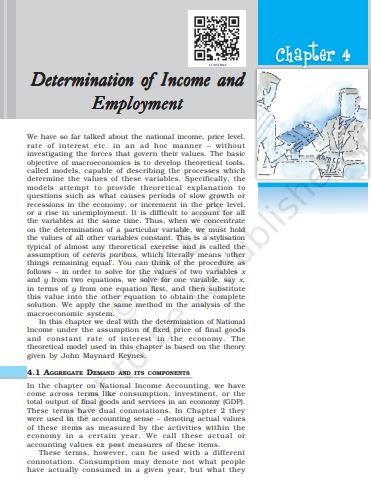‘NCERT Solutions for Class 12 Economics Chapter 4 Determination Of Income And Employment‘ PDF Quick download link is given at the bottom of this article. You can see the PDF demo, size of the PDF, page numbers, and direct download Free PDF of ‘Ncert Class 12 Economics Chapter 4 Exercise Solution’ using the download button.
Determination Of Income And Employment NCERT Textbook With Solutions PDF Free Download

Chapter 4: Determination Of Income And Employment
In the chapter on National Income Accounting, we have come across terms like consumption, investment, or the total output of final goods and services in an economy (GDP). These terms have dual connotations.
In Chapter 2 they were used in the accounting sense – denoting the actual values of these items as measured by the activities within the economy in a certain year.
We call these actual or accounting values ex-post measures of these items. These terms, however, can be used with a different connotations.
Consumption may denote not what people have actually consumed in a given year, but what they had planned to consume during the same period. Similarly, investment can mean the amount a producer plans to add to her inventory.
It may be different from what she ends up doing. Suppose the producer plans to add Rs 100 worth of goods to her stock by the end of the year.
Her planned investment is, therefore, Rs 100 in that year. However, due to an unforeseen upsurge of demand for her goods in the market the volume of her sales exceeds what she had planned to sell and, to meet this extra demand, she has to sell goods worth Rs 30 from her stock.
Therefore, at the end of the year, her inventory goes up by Rs (100 – 30) = Rs 70 only. Her planned investment is Rs 100 whereas her actual, or ex-post, investment is Rs 70 only. We call the planned values of the variables – consumption, investment, or output of final goods – their ex-ante measures.
In simple words, ex-ante depicts what has been planned, and ex-post depicts what has actually happened.
In order to understand the determination of income, we need to know the planned values of different components of aggregate demand. Let us look at these components now.
Investment is defined as an addition to the stock of physical capital (such as machines, buildings, roads, etc., i.e. anything that adds to the future productive capacity of the economy) and changes in the inventory (or the stock of finished goods) of a producer.
Note that ‘investment goods’ (such as machines) are also part of the final goods – they are not intermediate goods like raw materials.
Machines produced in an economy in a given year are not ‘used up’ to produce other goods but yield their services over a number of years.
Investment decisions by producers, such as whether to buy a new machine, depend, to a large extent, on the market rate of interest. However, for simplicity, we assume here that firms plan to invest the same amount every year.
| Author | NCERT |
| Language | English |
| No. of Pages | 13 |
| PDF Size | 1.6 MB |
| Category | Economics |
| Source/Credits | ncert.nic.in |
NCERT Solutions Class 12 Economics Chapter 4 Determination Of Income And Employment
1. What is marginal propensity to consume? How is it related to marginal propensity to save?
MPC or Marginal Propensity to consume is a vital component of the Keynesian theory of macroeconomics and it is defined as the increase in consumer spending due to an increase in income. It is expressed as ∆C/∆Y which shows the change in consumption with a change in income.
Where ∆C = Change in consumption
∆Y = Change in Income
MPC and MPS (Marginal propensity to save) are related as follows
MPC + MPS = 1
or MPS = 1- MPC
or MPC = 1- MPS
For example, If a person gets Rs. 1000 extra as bonus, and if he spends around Rs. 700 and saves 300, then his MPC will be 0.7 and MPS will be 300 or (1- 0.7) = 0.3.
2. What is the difference between ex ante investment and ex post investment?
| Ex-ante Investment | Ex-post Investment |
| The investment planned by the firms in the economy during a particular period of time is called ex-ante investment. | The actual investment that is made by all the entrepreneurs in the economy during a period is called ex-post investment. |
| The planning is done based on future expectations. | It is the result of actual investment |
3. What do you understand by ‘parametric shift of a line’? How does a line shift when its (i) slope decreases, and (ii) its intercept increases?
Consider the equation of straight line of the form b = ma + ε, where m > 0 is called the slope of the straight line (a) and ε > 0 is the intercept on the vertical ( b) axis. Any increase in a will result in increasing the value of b by a unit of m. Here m and ε are known as parameters of the graph and their role is to regulate the graph’s position.
Parametric shift refers to the changes in the curve due to change in value of the entities m and ε in the graph.
According to the conditions in question
i. If slope decreases then the consumption curve will shift downwards
ii. When intercept increases, the consumption curve will move parallelly with the intercept.
NCERT Class 12 Economics Textbook Chapter 4 Determination Of Income And Employment With Answer PDF Free Download
